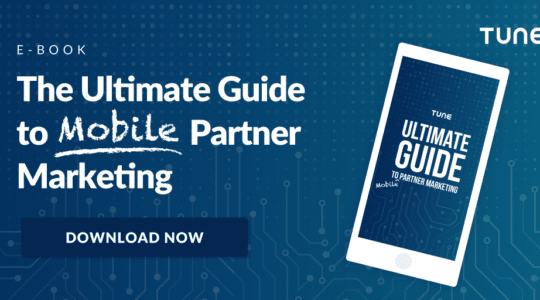
The de facto standard for pricing affiliate advertising software and hardware on the modern web is “as a service.” For example, software as a service (SaaS) companies like Dropbox, Slack, Oracle, and Salesforce all license their platforms on a subscription basis, while hosting the servers, databases, and code themselves. As an affiliate software provider, TUNE is no different. New “as a service” acronyms are popping up every day, fueled by our innate human desire to categorize things and companies’ love of a good acronym. Let’s canter through some history, discuss the present, and hopefully, preordain some future evolutions from this model.
Affiliate Advertising Software (as a Service)
The vast majority of web 2.0 technologies are sold on a software as a service pricing (SaaS) model. The idea of selling a monolithic, versioned application works in very few cases in the modern web. It prevents rapid innovation and often can render applications obsolete long before the next version is ready for market. These are only a few of the reasons TUNE’s affiliate software follows the SaaS model.
Without monthly billing, the business must also tolerate increased risk. While they may receive a massive tidal wave of money when the newest version of their product is released, between versions — when they have to pay engineers to support existing code or build the next great version — they have comparatively little income. This can constrain future versions to be the minimum viable product, lacking many features to differentiate them from the current version or competitor’s products. This has fueled the push into SaaS by almost every software company, including in the affiliate marketing industry, even causing Microsoft and Adobe to hybridize their licensing models.
IaaS: Infrastructure as a Service
With this model comes its own unique set of challenges, like high availability systems and more expensive ongoing architecture costs borne by the software provider. These considerations have led directly to the creation of IaaS (infrastructure as a service). This lesser-known AAS has directly driven the growth of affiliate advertising software, general SaaS, and traditional application developers for some time.
Infrastructure as a service was pioneered by Rackspace and others in the early 2000s to reduce overall cost of launching and supporting networked applications. Infrastructure as a service allows businesses to vastly reduce their ongoing infrastructure cost by providing on-demand systems in a secure, highly managed environment. Some of the omnipresent players in this space are Amazon, Microsoft, Google, IBM, and HP.
It really came into its own with SaaS supporting it; however, too frequently IaaS requires a full team of infrastructure engineers to manage and support the virtual data center. This cost fueled the next expansion of the AAS lexicon: PaaS.
PaaS: Platform as a Service
Platform as a service (PaaS) provides many of the tools required to launch an application packaged into a single, cohesive offering. Amazon Web Services (AWS) is becoming the canonical example of a comprehensive PaaS offering; it provides everything from virtual server instances, to multiple data storage structures, to machine learning services, to call center services. (We run much of our affiliate advertising software with the help of AWS.) Other services provide a less generalized offering that specifically targets app development or web app development.
With all of these amazing AAS acronyms running around the modern enterprise, how do you get your PaaS to work with your existing IaaS and the 20+ SaaS products that you’re likely making use of?
Well, you use an iPaaS to help knit them all together. The integration platform as a service (iPAAS) solves the ongoing problem of tying together these underlying systems. It makes these connections reliable, easily supported, and — most crucially — significantly less expensive from a capital and operational cost perspective.
The Future of Affiliate Advertising Software
This brings us to the current day, with enterprises ever looking for lower-cost and lower-maintenance ways to receive mission critical support services. Where do I think affiliate software and other SaaS companies will go from here?
I believe that the iPaaS industry will become the game-changing sales channel that SaaS providers have always dreamed of. We will begin to see iPaaS offerings channel selling a prepackaged, industry-specific support stack. These will become the new “services” that businesses will buy; they will have a low client churn and allow for underlying AAS services to be swapped out with limited impact to the client. It’s going to be a brave new world allowing companies to focus on their service and sell primarily through business development relationships, keeping sales overhead low.
At TUNE, we’re still doing our part to shape the affiliate advertising software market, and the future market. We once existed as two pure SaaS products, but as we work to be more wall-less, we open up a world of possibility. Do we continue the trend toward becoming a PaaS, enabling our clients to build everything they need within a simplified sandbox? Do we knit together a packaged iPaaS offering? How much benefit would the industry see from a packaged affiliate software play that solves all of their business needs? How do our products evolve to meet this potential future, where partner marketing and affiliate marketing are joining teams?
These are the questions that drive us to keep building the best affiliate advertising software (as a service) we can possibly imagine.
Author
Becky is the Senior Content Marketing Manager at TUNE. Before TUNE, she handled content strategy and marketing communications at several tech startups in the Bay Area. Becky received her bachelor's degree in English from Wake Forest University. After a decade in San Francisco and Seattle, she has returned home to Charleston, SC, where you can find her strolling through Hampton Park with her pup and enjoying the simple things in life.




Leave a Reply
You must be logged in to post a comment.